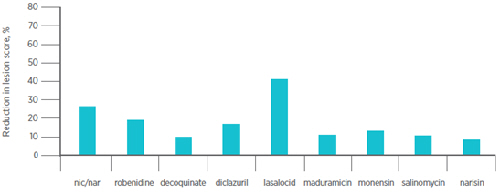



Anticoccidial-sensitivity Testing Shows Consistency, Efficacy of Lasalocid
Recent testing of the most widely used in-feed anticoccidials show they all produce variable results with different Eimeria isolates, but the divalent ionophore, lasalocid, produced the best combination of efficacy and consistency, according to Zoetis.“The study results are not meant to be used as generalized advice favouring one product over another. They merely provide trends,” said Vasil Stanev, DVM, poultry technical manager for intestinal health in Europe, Africa and the Middle East, Zoetis, Inc.
“In the field, anticoccidial programmes need to be based on sensitivity testing and the history of anticoccidial use on individual poultry farms,” he said.
In the study, investigators obtained 134 field isolates of Eimeria – the protozoan parasite that causes coccidiosis – from farms in Europe, the Middle East and Africa between the years 2000 and 2012. Anticoccidial-sensitivity testing was performed at the French National Institute for Agricultural Research, Nouzilly, France.
After the species of each Eimeria isolate was determined and reproduced, investigators infected birds known to be free of Eimeria with a dose of an isolate high enough to cause severe coccidiosis. The day before inoculation, anticoccidial treatment was initiated.
The study included coccidial-free control groups of uninfected birds; some were treated with anticoccidials and some were not, Dr Stanev continued.
Weight Gain Improvement
The only anticoccidials that resulted in an average weight gain improvement of more than 40 per cent were the ionophore lasalocid, the two synthetic products robenidine and decoquinate and the combination of narasin-nicarbazin, he reports.
Of the ionophores, lasalocid was the only one that resulted in more than a 50 per cent improvement in average weight gain, which may be due to the difference in its mode of action, says Stanev, who presented the results of the study at the 2013 World Veterinary Poultry Association annual congress in Nantes, France.
Among synthetic products, average weight gain improvement was 42.8 per cent with robenidine, 45.5 per cent with decoquinate and 57.4 per cent with the combination of narasin-nicarbazin, he says, noting that the synthetic product diclazuril provided an average weight gain improvement of only 15.6 per cent.
The ionophore products in general were more consistent in their efficacy, with a standard deviation (SD) – the variation from average – of 18.2 to 24.0, Dr Stanev said. The SD for lasalocid was only 19.6. The synthetic products showed higher variations, with SDs ranging from 25.8 to 39.2.
“This is probably due to the different patterns of resistance development for both ionophore and synthetic products,” he commented.
Lesion Scoring
Eimeria acervulina was most sensitive to decoquinate, resulting in a lesion-score reduction of 42.5 per cent, followed by the combination of narasin-nicarbazin and robenidine.
Strains of E. maxima were most sensitive to lasalocid, which reduced lesion scores by nearly 46 per cent (Figure 1), Dr Stanev said.

E. tenella strains were most sensitive to decoquinate, which reduced the lesion score by more than 73 per cent, he says.
The monovalent ionophores salinomycin, monensin and narasin as well as the glycoside ionophore maduramicin showed lower efficacy, which was demonstrated by weaker sensitivity of different Eimeria species. Strains of E. acervulina were the most sensitive to these anticoccidials and E. maxima strains were the most resistant, Dr Stanev said.
The lower efficacy of the monovalent ionophores could be related to their overuse as well as to the cross-resistance among them, he says.
“You might say that coccidial resistance is farm-dependent. If a farm has used the same anticoccidial for too long, it will not be effective. On another farm, that same product might work perfectly well if it hasn’t been used there for too long,” Dr Stanev said.
To maintain good coccidiosis control and flock performance, the veterinarian advises anticoccidial-sensitivity testing of isolates from individual farms. The results, coupled with the history of anticoccidial use, could provide the information needed to help producers and their veterinarians select the best anticoccidials to use in an appropriate rotation programme.
June 2014












